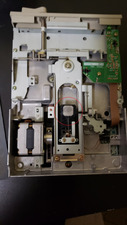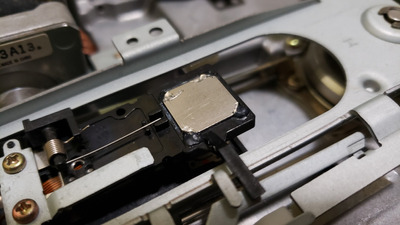First post, by trigolet_rodolphe
- Rank
- Newbie
Well, I need help with an old floppy drive...
I picked up an old Teac FD-55GFR some months ago. It's a beautiful drive, it works well, and I'd love to use it more, but it has a bit of an age-related flaw related to a metal piece that goes on top of the drive head.
It appears that, once upon a time, it was glued to the plastic drive head housing with some white adhesive. On this drive, that adhesive appears to have long since dried up. Lowering the drive head and reading disks works perfectly fine. The moment you raise the drive head using the lever, that metal bit goes FLYING... unless you're being super slow and gentle when working that lever. As one can imagine, having a bit of metal flying around inside of an operating PC is not exactly conducive to ensuring the system's long-term longevity!
SO, my question: What kind of adhesive might one be able to use to glue that metal bit back into place? I've attached a photo of my drive showing with the piece I'm talking about circled in red.
I appreciate any and all input. Thank you!
Chieko: AMD K6-2 366MHz / Matrox Millennium II / Voodoo2 / SB16 MCD
Takako: Pentium III 700MHz / Voodoo3 3000/ Yamaha YMF-724
Yuko: Pentium 4 2.4GHz / ATI Radeon 9600XT / SiS 7012 AC'97

